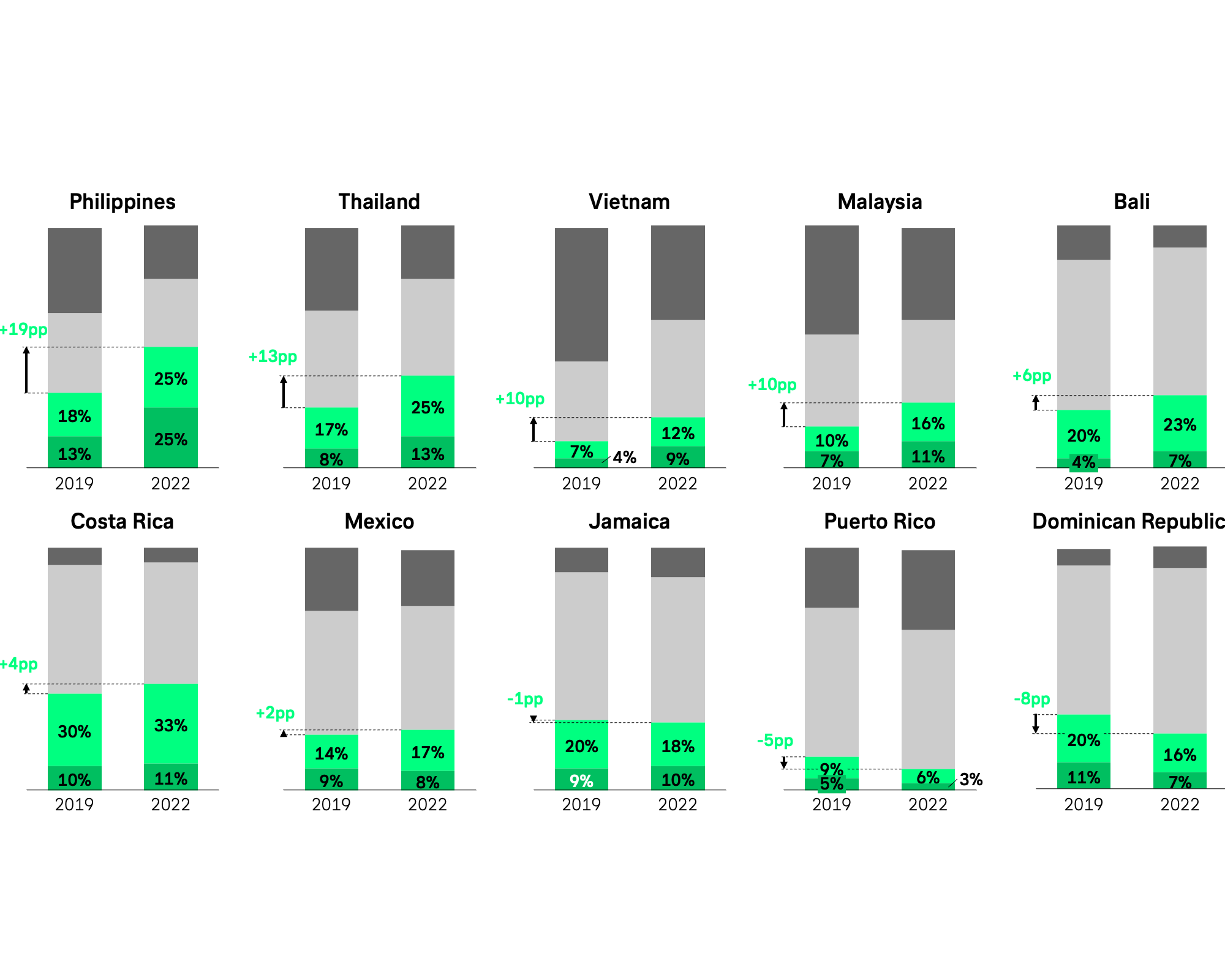Around the world, an unprecedented amount of venture capital is flowing into ride-, bike-, and home-sharing startups, hence, they have been able to scale with astonishing speed. Reflecting this abundance of funding, these categories dominate and define the public picture of Travel & Mobility Tech.
There is another category in Travel and Mobility Tech, however, that likewise emerges from the omnipresent sharing economy and marketplaces — Tours & Activities. While this category is only starting to gain interest in the rest of the world, Asia has long been the global driving force of this category.
A brief introduction to Tours & Activities in Asia
Over the years, there has been a significant shift in consumerism from physical goods to services and experiences. Thus, 72 percent of U.S. consumers say they would like to increase their spending on experiences rather than material things in the next year. This is the experience economy — and travel is a vital part of it. Travelers want to have memorable, and life-changing experiences. For this reason, global travelers have been adjusting their budgets to include more experiences. German travelers are a prime example: They already spend more money on experiences than on transportation.
In 2017, Asia-Pacific had 324 million international tourist arrivals — a 6 percent growth rate, which is expected to continue in 2018. Additionally, tourist spending in the Asia-Pacific region outpaces other regions in the world.
At the moment, we see growing interest from industry giants as Booking.com, Expedia, Marriott and, first and foremost, Airbnb — making this must-watch category essential for anyone in Travel & Mobility Tech. Industry experts are shifting their focus towards Asia trying to understand the dynamics driving this category.
The first wave of Asian ventures leveraged technology to digitize and consolidate activity inventory for Western travelers coming to Asia
Inspired by the success of online marketplaces, networks, and platforms, early ventures leveraged online technology to start digitizing the offline, analog, and fragmented business of tours and activities. On the one hand, category growth is still driven by the strong desire to pay for authentic experiences as well as the need to sell excess capacity by tour operators. It’s a classic two-sided marketplace. Trends like widespread connectivity, new content and media formats, social media and e-commerce, in general, are fueling innovation in this category.
Over time two characteristic styles have not only emerged but are starting to coalesce:
- Professional activity marketplaces that include sightseeing tickets — comparable to Viator or Tiqets.
- Crowdsourced tours that connect international travelers and locals — comparable to GetyourGuide.
Pioneering Asian ventures of this first wave include: Trip Dixi & TripTrus (Indonesia), MyRealTrip (South Korea), Meetrip (Japan), and FlipTrip (Philipines).
The scope of these first-wave digital solutions, however, was usually limited to a single geographic market — sometimes one country, sometimes a single island. It was not only necessary to know the market but to be physically present to motivate and onboard tour operators. As a consequence, the category itself remained fragmented as a whole.
In sum, issues like a varying size and quality of inventory, the need for face-to-face business development, and different technical infrastructures tend to discourage significant amounts of venture capital. Which is why none of these ventures was able to scale in a big way.
The second wave of Asian Travel & Mobility Tech ventures exploits the rise of domestic travel
China’s middle and upper-class has experienced increased purchasing power and shows a willingness to spend on travel. A group of Asian ventures has responded to this trend, focusing on the “new average” Asian traveler within their respective local market. In recent years, this segment has witnessed growing interest from venture capital, both locally and globally.
A notable player riding this wave is Yaochufa, an OTA specializing in customized travel packages like weekend getaways — an emerging vacation format for Asian travelers. Another interesting venture is Yikuaiqu, a scenic attraction booking service in China. The company offers B2C-services via their website or WeChat as well as B2B-products to companies like Ctrip or Meituan.
The significant growth of this customer segment — above 10% in China alone — offers a clear signal that this subsegment will most certainly see further dynamic growth.
The third generation of ventures meets Asian travelers’ unmet demands overseas
Over the last few years, the number of Chinese outbound travelers has grown consistently by around 5%, reaching 135 million in 2016. Their travel behavior, which is constantly evolving, shows a unique blend of local Chinese consumption habits and a desire to absorb global trends. Around 80% of these Chinese outbound travelers book some sort of travel package or tour guide activity. A similar development is evident in many Asian countries. A lot of Asian ventures are thus focusing on local travelers traveling abroad.
Western offerings, by comparison, seem unable to address the unique needs of this type of traveler. Not only is China’s travel powerhouse Ctrip focusing on this segment, but so is a growing number of startups including Mioji, an A.I.-powered itinerary planner targeted at Chinese outbound travelers.
These ventures truly understand their consumers, providing authentic services tailored to their needs and turning them into soaring profits.
One to rule them all — the newest wave of Tours & Activities ventures comprises all three previous waves
The lines are fading: It’s increasingly difficult to separate having a market and an audience focus. Technological advance drives innovation across all Travel & Mobility Tech categories. Tour & Activity marketplaces are entering the next evolutionary phase with the further consolidation of once-isolated markets and the integration of technological infrastructures.
In the course of the first wave of insular digitization, a phase of inventory consolidation has swept through the Tours & Activities category. These new players tend to follow a more general approach when it comes to user segmentation and market, focusing on building global brands with mass appeal and quickly scaling them beyond their home market.
As tour operators have become more tech-savvy and able to find services on their own, branding, customer acquisition, and corporate partnerships have gained greater importance than growing inventory. This not only exploits the trend of multi-country trips — allowing travelers to book their activities on one platform, increasing the share of wallet — but also reduces customer acquisition costs along with overall operational costs.
In the future, this segment will merge with the skyrocketing segment of domestic travelers and thus diminish the industry’s prevailing customer segmentation. New technology already enables companies to target different segments with personalized offerings over the same platform.
Klook from Hong-Kong ($96.5M) and its Taiwanese persecutor KKday ($22M) are both substantially funded and on their way to becoming the Didi of their category. They each focus on the classic professional activity-marketplace model, while Triip from Vietnam crowdsources locals to guide visitors to the lesser-known charms of a destination. The venture has registered over 10,000 “local experts” and conducted more than 7,000 tours in over 635 cities in 93 countries.
Meanwhile, Western category leaders like Uber and Airbnb fall short in addressing Asian customers and are unable to utilize their growth playbooks in Asian markets.
Asia’s dominating tech platforms like Tencent, Alibaba, Xiaomi, Huawei etc. continue to increase their global footprint, but it remains uncertain whether pure Asian players can convince Western consumers to use their products, especially in Travel & Mobility Tech. We are therefore closely watching the market entrances of Didi, Obike, Mobike, and others in Europe and the rest of the world.
With Didi, Tujia, Ofo, etc. Asia has proven it can build its very own category leaders. It remains to be seen, however, if the region can establish a leader in Tours & Activities and scale it to a comparable size.













